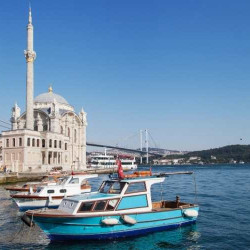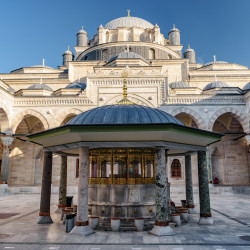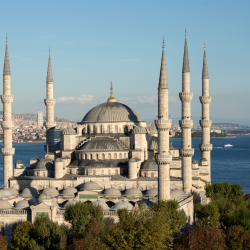The Blue Mosque
Greco Roman Ottoman Cultural Milieu & The Story of “Le Carnaval A Constantinople” - A Carnival of Hippodrome of Constantinople -The Sultan Ahmet Square & Hagia Sophia!
The Blue Mosque dominates Istanbul’s majestic skyline with its elegant composition of ascending domes and six slender soaring minarets with its unique location right in the epicenter of two big empires and civilizations; Hippodrome of Constantinople -The Sultan Ahmet Square, next to the Hagia Sophia like an unending fight of supremacy that will last for centuries.
Representing a silent war of the Byzantine and Ottoman Empires of Istanbul which was the capital of two great empires, the rivalry between the two monuments is difficult to ignore. The Blue Mosque can generally be considered one of the last classical Ottoman structures and both buildings overwhelm with their massive proportions and their individual claims on the city’s history.
The Blue Mosque is the perfect combination of powerful aesthetics and architectural mastery. Embodying the epitome of Byzantine-influenced Ottoman construction, the Blue Mosque was completed in 1616 with heavy inspiration from Hagia Sophia in its construction.
While the Blue Mosque awes with its beauty, polished architecture and wonderful lighting, it also captivates with its size, scale, and the mixture of religious and cultural history.
Where is Blue Mosque?
The Unique Location of the Blue Mosque
The incorporation of new architectural and decorative elements in the Blue Mosque’s design and its symbolic placement at the imperial center of the city makes it magnificent. Hippodrome of Constantinople -The Sultan Ahmet Square & Hagia Sophia!
What Area Is The Blue Mosque In Istanbul?
The area where the Blue Mosque is located was known as the “Hippodrome” during the Byzantine and as “Horse Square” during the Ottoman Empire.
Hippodrome of Constantinople – Sultan Ahmet; The square and the Hippodrome (the Horse Square’s name was changed as the Sultan Ahmet Square after the construction of the Sultanahmet Mosque (the Blue Mosque) functioned as assembly areas or celebration venues throughout history hosting also rebellions.
Also, a part of the Byzantine Imperial Palace was located in the same area and during the 16th century and senior Ottoman offices were found in the area.
Who Built Blue Mosque Istanbul?
Sultan Ahmet, I appointed his royal architect Sedefkar Mehmet Aga, a pupil and senior assistant of the famous architect Mimar Sinan to be in charge of the Mosque construction.
Sultan Ahmet I - A Young Sultan
A young sultan in charge of an empire expanding three continents—Asia, Europe, and Africa! Having been enthroned as young as 13 years of age, Sultan Ahmet I was confronted with the legacy of great rulers before himself such as the Magnificent Suleiman and Mehmet the Conqueror.
Ahmet I was the sultan of the Ottoman Empire from 1603 until his death in 1617, succeeding his father Mehmed III at the age of 13. Sultan Ahmet’s reign was marked with decline and failure, both for him personally and for the empire at large.
Yet, being neither a renowned warrior nor an experienced-skilled administrator, Sultan Ahmet I wanted to leave his mark on the fabric of the city that his forbears coveted and conquered.
Why Was The Blue Mosque Constructed?
The ruling Ottoman Sultan ‘Sultan Ahmet’, known for his religious devotion had a great desire of building a mosque that would symbolize the love of God inside him and would leave Hagia Sophia behind with its glory.
Building a great mosque next to the Hagia Sophia would also signify the triumph of an Islamic monument over a converted Christian church, a matter of great concern even 150 years later the Ottoman conquest of Istanbul in 1453.
When Was The Blue Mosque Istanbul Built?
The sad part of the history that Sultan Ahmet I did not live very long, he died when he was 27 years old and the Blue Mosque, was completed in 1616 just prior to the untimely death of the Sultan.
A Politically Charged & Symbolic Location
Sultan Ahmet I selected a site on the Hippodrome of Constantinople, overlooking the Sea of Marmara, on which two large palaces were already constructed.
The location of the Blue Mosque is politically charged, as uniquely positioned right in between the Hagia Sophia and the Byzantine Hippodrome near the Ottoman royal residence, Topkapı Palace.
The Blue Mosque was built on the site of the palace of the Byzantine emperors, facing the Hagia Sophia and the hippodrome, which was a site of great symbolic significance. Large parts of the Sphendone (curved tribune with U-shaped structure of the hippodrome) had to be removed to make room for the new mosque.
The Architecture of The Blue Mosque - What Is The Blue Mosque Made Out Of?
With one main dome, eight secondary domes and six minarets, the design of the Blue Mosque is the culmination of two centuries of Ottoman Islamic architectural art. Its central dome sits on delicate triangular segments of a spherical surface with its weight supported on four massive fluted columns.
In light of extending the prayer space beyond the span of the central dome, a series of eight secondary half-domes cascades outwards from the center to ultimately join the exterior walls of the mosque.
The Islamic architecture of the Blue Mosque deeply reminds some Byzantine Christian elements of the neighboring Hagia Sophia. Although Hagia Sophia opened its doors in A.D. 537, the Ottoman architects a millennium later drew inspiration from it and incorporated much of the overall plan in their finest designs.
The Blue Mosque is considered to be the last great mosque of the classical period with its overwhelming size, majesty, and splendor.
What Makes Blue Mosque Famous In The World?
The secret of 6 minarets, tiles, the dominance of the blue color, finely carved and sculptured marble Mihrab and the magnificent exterior of the Blue Mosque all together make the Blue Mosque famous in the world.
The Secret of Six Minarets - Why Blue Mosque has 6 minarets?
There are 6666 verses in the holy book of Islam. Although six minarets were unusual even for an imperial mosque at that time, 6 minarets were built representing the verse numbers of the Islamic Holy Book.
While four of the six minarets are positioned at the corners of the Blue Mosque, the other two minarets are positioned at the end of the forecourt.
The four minarets at the corners are fluted, pencil-shaped minarets with three balconies and stalactite corbels. The other two minarets at the end of the forecourt only have two balconies. The Blue Mosque is one of three mosques in Turkey to have six minarets today.
The Tiles of the Blue Mosque
The interior of the Blue Mosque is world famous with its more than 20,000 handmade ceramic tiles. Those tiles were made at Iznik area (the ancient Nicaea) with more than fifty different tulip designs.
The Iznik tiles are the ‘main glory’, stemming from Ahmed’s great love of tile decoration, and are also the reason why the Sultanahmet mosque is commonly known as the Blue Mosque.
All sides of the interior are covered in rich, padded carpets, beautiful stained-glass windows, or intricately decorated Islamic decorations and calligraphic script.
The decorations of the Blue Mosque interior are embellished through the use of tiles with magnificent floral designs that display ancient lily, carnations, tulip and rose motifs, as well as trees like cypresses.
While gallery tiles are deeply focused on flamboyant with representations of flowers, fruit, and cypresses; The tiles at lower levels are mostly seen in traditional designs. Traditional motifs on the tiles such as cypress trees, tulips, roses, and fruits evoke visions of a bountiful paradise.
The Dominance of Blue Color
Assisted by the magnificent chandeliers, the dominance of blue color can be clearly and easily noticed on more than 220 stained glass windows with intricate designs admitting natural light.
Although its official name is Sultan Ahmet mosque, the dominance of blue color is the very reason that the most commonly known name of it is; The Blue Mosque.
A Finely Carved & Sculptured Marble Mihrab
‘Mihrab’ is the most important thing ever of a mosque since it shows the direction of the Kaaba in Mecca and hence the direction that Muslims should face when praying. What A Mihrab That Is In The Blue Mosque – Such A Mihrab made of finely carved and sculptured marble, with a stalactite niche cypress motifs and a double inscriptive panel above itself!
A Mihrab surrounded by many windows with the walls sheathed in ceramic tiles. A very richly decorated minbar, or pulpit, where the imam stands when the sermons are delivered at the time of noon prayer on Fridays or on holy days.
The Exterior of The Blue Mosque
A 43-meter high dome with 23,5 meters diameter makes the Blue Mosque unique.
The court of the Blue Mosque has almost the size of the mosque itself and it is surrounded by a continuous vaulted arcade. There are ablution facilities on both sides. There is a central hexagonal fountain which is relatively small to the courtyard. Its narrow gateway to the courtyard stands out architecturally from the arcade.
There is a heavy iron chain hanging in the upper part of the court entrance by the western side. During the Ottoman times, only the sultan was allowed to enter the court of the Blue Mosque on horseback.
The reason why the chain was put there was to have the Sultan avoid hitting his head every time he entered the court. This chain represented the omnipotence of God and symbolized equality for all that entered the mosque.
Connecting Rooms
There were connecting rooms where the sultan could rest before and after his prayers. Those connecting rooms are located at the south-east corner and lead to the royal lodge in the Blue Mosque's upper gallery.
Those rooms had become the Grand Vizier's headquarters during the suppression of the Janissary Corps' rebellion in 1826. This section of the complex is supported by ten grand marble columns.
The History of The Blue Mosque’s Creation Steps
When Sultan Ahmet I, resolved to build a new imperial mosque, he did not anticipate the resistance his plans would meet.
It had been many years since a sultan had erected such a monument in the capital. The last one ‘Suleymaniye Mosque’ had been built by Sultan Ahmet’s great grandfather in 1557 who was the mighty Suleiman the Magnificent. The second half of the sixteenth century witnessed a lull in Ottoman imperial construction that reflected growing anxieties about the decorousness of such lavish architecture.
The Sultans Had To Refrain From Building Even Charitable or Religious Institutions If They “Have Not Enriched Themselves With The Spoils of Holy War
In a book of advice written in 1581 for Murad III, the historian Mustafa Ali asserted that ‘the sultans had to refrain from building even charitable or religious institutions if they “had not gotten themselves with the riches and the gains of Holy War and had not become owners of lands through gains of campaigns of the Faith’.
The reason for that objection was that "the Divine Laws did not permit the building of charitable establishments with the means of the public treasury, neither did they allow the foundations of mosques and medreses that were not needed. This was voiced at a time when the Ottoman Empire was not expanding at the rate it had under earlier sultans.
Far from expanding the empire, Sultan Ahmet I lost important territories to the Safavids in 1604, and was forced in 1606 to concede parity with the Habsburg emperor, who no longer had to pay the annual tribute that had been instituted in the time of Suleiman – The magnificent.
Objections From The Grand Mufti
The legality of the site did not, however, settle the questions raised by the construction itself. The grand mufti at the time said that the mosque would be needless in its intended setting, which lacked a large congregation. Also, the more serious issue was of the sultan’s military shortcomings still loomed.
The Death of Sultan Ahmet I
Sultan Ahmet, I died of typhus at the age of 27 on November 22, 1617, only three months after his mosque was inaugurated. Most of the Blue Mosque‘s ancillaries including the madrasa, public kitchen, and marketplace were unfinished upon the sultan's death. The complex was completed in 1620.
Sultan Ahmet’s own tomb is located not in the garden behind the mosque's qibla wall, but in a more visible spot outside at the northernmost end of the complex. The tomb faces and competes with the dynastic mausolea of the Hagia Sophia.
The Blue Mosque & Hagia Sophia – The Comparison
Comparison between The Blue Mosque & Hagia Sophia is rendered inevitable by their stylistic resemblance and the similarity of their dimensions.
The Blue Mosque’s doubling of semi-domes and emphasis on pyramidal verticality arguably make for a more impressive effect. The same principle is at work in the use of minarets.
The shrewd design of the Blue Mosque also equips itself. The use of four semi—domes serves more clearly to differentiate the newer structure, whose rhythmic cascade of domes presents a marked contrast to the rather ungainly exterior of the converted sixth century church.
The emphatically beautiful exterior of the Blue Mosque is able to challenge the Hagia Sophia despite being smaller in size.
The unyielding visual appeal of the Blue Mosque is once more bolstered by its six minarets, which on the one hand mirror the Hagia Sophia’s placement of four towers at the corners of the prayer hall, but on the other surpass their earlier counterparts in number as well as aesthetic coherence. The minarets of the Hagia Sophia are mismatched accretions of different periods.
Can You Visit The Blue Mosque?
The Blue Mosque is a place of worship and surely you can visit the mosque.
What to Wear Blue Mosque?
There is a dress code for the Blue Mosque. Women should cover their arms, legs and hair. Opt for loose-fitting clothes that don’t cling to form. Avoid leggings. Men should cover their legs. Opt for loose clothes and avoid singlets and vests
Be warned that officials assess every visitor and if you fail to meet the Blue Mosque dress code, you will be asked to cover up with a scarf, skirt or robe which the Mosque lends to you for free.
How To Visit The Blue Mosque?
There are a few rules and tendencies regarding how to visit the Blue Mosque. The Blue Mosque is a place of worship so be quiet and respectful.
You must take off your shoes and put them in a clear plastic bag. A free bag is provided right by the entrance. You can either carry the bag with you or leave it in a cubby hole inside the mosque.
You can take pictures inside the Blue Mosque but turn off your flash. Don’t photograph people in prayer or as they perform their ablutions.
You can put used plastic bags in the designated bin bags on exit. Return head covers to the mosque staff on exit. Entry to the Blue Mosque is free.
What Time Blue Mosque Opens & When Is Blue Mosque Closed?
Sultan Ahmet Camii (Blue Mosque) is still a working mosque and is therefore closed to tourists during prayer time. In general, the opening hours of the Blue Mosque Turkey are from 08:300 am until one hour before dusk each day, excluding 90 minutes each prayer time, and two hours during Friday noon prayers.
The Blue Mosque opens before morning pray around 05:30 for All Muslims from any country or nationals until the last praying time. Also anyone can visit to pray but you can not take pictures on prayer time.
Blue Mosque To SAW Airport & Blue Mosque To Istanbul Airport
You think city lines are such an hassle or too tiring, then we surely have ways for your super fast & super comfortable transfer to airports. Our professional staff is ready for private transfers to Istanbul Airport & Sabiha Gokcen airport
Yes indeed; In-depth discovery means every opportunity is explored. Be informed, educated, rested, relaxed and revitalized with us through “Discovering Istanbul - Truly an art!”
For We Loved You So Much That We Gave Our Only Look &Touch; So That Your Istanbul Trip is Not To Perish But Have Everlasting Life! Come & Discover Istanbul with US!
 French
French  Indonesian
Indonesian  Urdu
Urdu  Taiwanese
Taiwanese  Russian
Russian  Romanian
Romanian  Portuguese
Portuguese  Persian
Persian  Macedonian
Macedonian  Korean
Korean  Japanese
Japanese  Italian
Italian  Indian
Indian  Hungarian
Hungarian  Greek
Greek  German
German  Croatian
Croatian  Chinese
Chinese  Bulgarian
Bulgarian  Arabic
Arabic  Spanish
Spanish  English
English 



